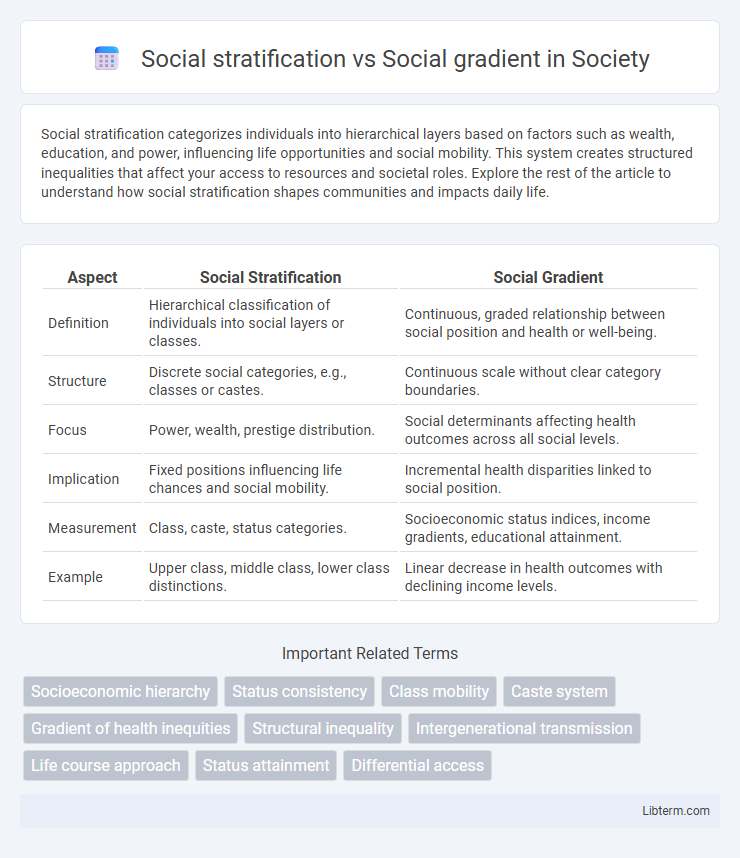Social stratification categorizes individuals into hierarchical layers based on factors such as wealth, education, and power, influencing life opportunities and social mobility. This system creates structured inequalities that affect your access to resources and societal roles. Explore the rest of the article to understand how social stratification shapes communities and impacts daily life.
Table of Comparison
| Aspect | Social Stratification | Social Gradient |
|---|---|---|
| Definition | Hierarchical classification of individuals into social layers or classes. | Continuous, graded relationship between social position and health or well-being. |
| Structure | Discrete social categories, e.g., classes or castes. | Continuous scale without clear category boundaries. |
| Focus | Power, wealth, prestige distribution. | Social determinants affecting health outcomes across all social levels. |
| Implication | Fixed positions influencing life chances and social mobility. | Incremental health disparities linked to social position. |
| Measurement | Class, caste, status categories. | Socioeconomic status indices, income gradients, educational attainment. |
| Example | Upper class, middle class, lower class distinctions. | Linear decrease in health outcomes with declining income levels. |
Understanding Social Stratification
Social stratification refers to the hierarchical arrangement of individuals or groups in a society based on factors such as wealth, power, and social status. It creates distinct social layers, influencing access to resources, opportunities, and privileges. Understanding social stratification helps reveal patterns of inequality and social mobility within complex social systems.
Defining the Social Gradient
The social gradient refers to the continuous and measurable relationship between socioeconomic status and health outcomes, where each step down the social hierarchy correlates with a proportional decline in health. Unlike social stratification, which categorizes society into distinct layers or classes, the social gradient emphasizes an incremental scale highlighting inequalities at every level. This gradient effect reveals that disparities in health are not confined to the poorest groups but exist across the entire spectrum of social positions.
Historical Perspectives on Social Hierarchies
Social stratification has historically referred to rigid, often legally enforced hierarchical divisions based on class, caste, or status, exemplified by feudal societies and caste systems like those in medieval Europe and India. Social gradient emphasizes a more continuous and dynamic spectrum of social status where health and life chances vary incrementally across economic or social positions, a concept rooted in public health studies and modern sociology. Histories of social hierarchies reveal how stratification systems codified inequality, while the social gradient illustrates subtler, pervasive inequalities influencing well-being across entire populations.
Key Differences: Stratification vs. Gradient
Social stratification refers to the hierarchical arrangement of individuals into distinct social classes based on factors such as wealth, power, and prestige, often resulting in rigid divisions and clear boundaries between groups. Social gradient describes a continuous spectrum of social position where health and well-being improve progressively with higher socioeconomic status, emphasizing incremental differences rather than discrete categories. The key difference lies in stratification's categorical class divisions versus the gradient's emphasis on gradual, proportional changes across the social hierarchy.
Impact on Health and Well-being
Social stratification creates distinct hierarchical layers based on socioeconomic status, influencing access to healthcare, education, and resources essential for health and well-being. The social gradient in health demonstrates that health outcomes progressively improve with each step up the socioeconomic ladder, reflecting a continuous relationship rather than fixed categories. Both concepts highlight how inequality in income, occupation, and social status contributes to disparities in physical and mental health across populations.
Socioeconomic Mobility and Barriers
Social stratification categorizes individuals into hierarchical layers based on socioeconomic status, influencing access to resources and opportunities, while social gradient describes the continuous, graded relationship between socioeconomic position and health or well-being. Socioeconomic mobility refers to the ability of individuals or groups to move up or down this hierarchy, often constrained by structural barriers such as education inequality, discrimination, and limited access to social capital. Overcoming these barriers is crucial for enhancing upward mobility and reducing the disparities embedded within social stratification and gradients.
Power Dynamics in Social Structures
Social stratification refers to the hierarchical arrangement of individuals or groups in society based on factors like wealth, status, and power, creating distinct social classes with unequal access to resources. Social gradient emphasizes the continuous, graded nature of social inequalities, where power dynamics influence health, education, and opportunity across all levels rather than distinct categories. Power dynamics in social structures reinforce both stratification and gradient by controlling resource distribution, shaping social mobility, and perpetuating systemic advantages for dominant groups.
Measuring Social Inequality
Social stratification categorizes society into hierarchical layers based on socioeconomic status, while social gradient illustrates the continuous relationship between social position and health outcomes. Measuring social inequality involves analyzing indicators such as income distribution, educational attainment, occupational status, and access to healthcare across these social layers. Quantitative methods like the Gini coefficient, relative index of inequality (RII), and concentration index effectively capture variations in wealth, education, and health correlated to social standing.
Policy Implications and Solutions
Social stratification and social gradient both highlight disparities in wealth, education, and health within societies, influencing policy-making focused on reducing inequality. Effective policies target structural factors by improving access to education, healthcare, and economic opportunities across all social strata, promoting equity rather than mere poverty alleviation. Addressing the social gradient requires interventions at multiple levels, ensuring incremental improvements in social conditions yield better health and social outcomes throughout the entire population.
Future Trends in Social Hierarchies
Emerging future trends in social hierarchies emphasize a shift from rigid social stratification toward more fluid social gradients shaped by dynamic factors such as technology access, education equity, and economic mobility. Increasing digital inclusion and data-driven policies contribute to reducing traditional class boundaries, fostering nuanced layers within social structures instead of fixed divisions. These evolving patterns suggest a more complex and interconnected social hierarchy where position is influenced by multiple, intersecting dimensions rather than static status markers.
Social stratification Infographic

 libterm.com
libterm.com